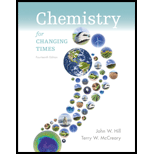
(a) Concentrated solution
Interpretation:
A concentrated solution contains a relatively large amount of solute.
Concept Introduction:
A solution is a heterogeneous mixture of two or more components. The solution is further divided into two components namely- solute and solvent. Solute is the minor constituent of the solution whereas the solvent is the major constituent. There is no visible layer of separation between the components of solution since the since the size of the solute particles is between 1-100nm.
E.g. sugar solution, the sugar added to water is solute and water is the solvent.
Some solutions have a high concentration of solute while some have low concentration. Since the amount of substance is comparable to the other hence, the solutions thus prepared are also comparable.
The relative terms used for them are concentrated and dilute.
A concentrated solution has more amount of solute dissolved in it as compared to the dilute solution.
(b) Dilute Solution
Interpretation:
A Dilute solution contains a relatively less amount of solute.
Concept Introduction:
There are two relative terms - dilute and concentrated. These two terms do not provide any quantitative information - but they are often useful in comparing the solutions. It just tells which solution has lesss amount of solute in comparison to the other.
(c) Soluble
Interpretation:
The term soluble implies a solute is fairly soluble in a solvent.
Concept Introduction:
Solubility is defined as the maximum amount of solute that can be dissolved in 100 g of solvent at a certain temperature to obtain a saturated solution. A saturated solution is a solution that has attained equilibrium and no further solute can be dissolved in the solution.
(d) Insoluble
Interpretation:
The term insoluble implies a solute is poorly soluble in a solvent.
Concept Introduction:
Solubility is defined as the maximum amount of solute that can be dissolved in 100 g of solvent at a certain temperature to obtain a saturated solution. A saturated solution is a solution that has attained equilibrium and no further solute can be dissolved in the solution.
If a solute does not dissolves completely in a particular solvent in any ratios, then the solute is said to be insoluble in that particular solvent.
Want to see the full answer?
Check out a sample textbook solution
Chapter 5 Solutions
Chemistry For Changing Times (14th Edition)
- What is the final product when D-galactose reacts with hydroxylamine?arrow_forwardIndicate the formula of the product obtained by reacting methyl 5-chloro-5-oxopentanoate with 1 mole of 4-penten-1-ylmagnesium bromide.arrow_forwardIn the two chair conformations of glucose, the most stable is the one with all the OH groups in the equatorial position. Is this correct?arrow_forward
- please help me with my homeworkarrow_forwardhelparrow_forwardThe temperature on a sample of pure X held at 1.25 atm and -54. °C is increased until the sample boils. The temperature is then held constant and the pressure is decreased by 0.42 atm. On the phase diagram below draw a path that shows this set of changes. pressure (atm) 2 0 0 200 400 temperature (K) Xarrow_forward
- QUESTION: Answer Question 5: 'Calculating standard error of regression' STEP 1 by filling in all the empty green boxes *The values are all provided in the photo attached*arrow_forwardpressure (atm) 3 The pressure on a sample of pure X held at 47. °C and 0.88 atm is increased until the sample condenses. The pressure is then held constant and the temperature is decreased by 82. °C. On the phase diagram below draw a path that shows this set of changes. 0 0 200 temperature (K) 400 аarrow_forwarder your payment details | bar xb Home | bartleby x + aleksogi/x/isl.exe/1o u-lgNskr7j8P3jH-1Qs_pBanHhviTCeeBZbufuBYT0Hz7m7D3ZcW81NC1d8Kzb4srFik1OUFhKMUXzhGpw7k1 O States of Matter Sketching a described thermodynamic change on a phase diagram 0/5 The pressure on a sample of pure X held at 47. °C and 0.88 atm is increased until the sample condenses. The pressure is then held constant and the temperature is decreased by 82. °C. On the phase diagram below draw a path that shows this set of changes. pressure (atm) 1 3- 0- 0 200 Explanation Check temperature (K) 400 X Q Search L G 2025 McGraw Hill LLC. All Rights Reserved Terms of Use Privacy Cearrow_forward
 ChemistryChemistryISBN:9781305957404Author:Steven S. Zumdahl, Susan A. Zumdahl, Donald J. DeCostePublisher:Cengage Learning
ChemistryChemistryISBN:9781305957404Author:Steven S. Zumdahl, Susan A. Zumdahl, Donald J. DeCostePublisher:Cengage Learning ChemistryChemistryISBN:9781259911156Author:Raymond Chang Dr., Jason Overby ProfessorPublisher:McGraw-Hill Education
ChemistryChemistryISBN:9781259911156Author:Raymond Chang Dr., Jason Overby ProfessorPublisher:McGraw-Hill Education Principles of Instrumental AnalysisChemistryISBN:9781305577213Author:Douglas A. Skoog, F. James Holler, Stanley R. CrouchPublisher:Cengage Learning
Principles of Instrumental AnalysisChemistryISBN:9781305577213Author:Douglas A. Skoog, F. James Holler, Stanley R. CrouchPublisher:Cengage Learning Organic ChemistryChemistryISBN:9780078021558Author:Janice Gorzynski Smith Dr.Publisher:McGraw-Hill Education
Organic ChemistryChemistryISBN:9780078021558Author:Janice Gorzynski Smith Dr.Publisher:McGraw-Hill Education Chemistry: Principles and ReactionsChemistryISBN:9781305079373Author:William L. Masterton, Cecile N. HurleyPublisher:Cengage Learning
Chemistry: Principles and ReactionsChemistryISBN:9781305079373Author:William L. Masterton, Cecile N. HurleyPublisher:Cengage Learning Elementary Principles of Chemical Processes, Bind...ChemistryISBN:9781118431221Author:Richard M. Felder, Ronald W. Rousseau, Lisa G. BullardPublisher:WILEY
Elementary Principles of Chemical Processes, Bind...ChemistryISBN:9781118431221Author:Richard M. Felder, Ronald W. Rousseau, Lisa G. BullardPublisher:WILEY





